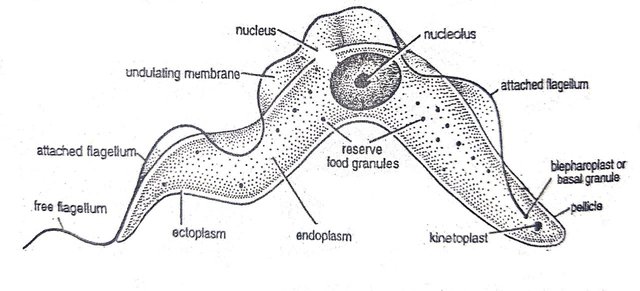
Image source : General Characteristics of Trypanosoma gambiense | Diagram
Trypanosoma gambiense is a parasitic protozoan that causes human African trypanosomiasis, also known as sleeping sickness. It is transmitted to humans through the bite of the tsetse fly, which can be found in rural areas of West and Central Africa. The parasite primarily affects the central nervous system, causing symptoms such as fatigue, headaches, and insomnia. As the disease progresses, it can lead to neurological problems such as confusion, disorientation, and difficulty walking. In later stages, it can lead to coma and even death if left untreated.
The incubation period of the disease can vary, but it is typically several weeks to several months after infection before symptoms begin to appear. The initial symptoms of sleeping sickness may be mild and easily mistaken for other illnesses, making it difficult to diagnose. The disease progresses in two stages: the first stage, also known as the hemolymphatic stage, is characterized by fever, swollen lymph nodes, and a skin rash. The second stage, known as the meningoencephalitic stage, is characterized by neurological symptoms such as confusion, disorientation, and difficulty walking.
T. gambiense is found in West and Central Africa, and it is estimated that around 300,000 people are infected with the parasite. The disease is most common in rural areas where tsetse flies are found and where people are in close contact with the vectors. Sleeping sickness is a serious public health problem in many parts of Africa and it poses a significant economic burden on affected communities.
Diagnosis of T. gambiense requires laboratory testing, and it can be difficult and prolonged. The most common diagnostic method is the detection of the parasite in the blood using microscopy. However, this method is not always reliable, and other methods such as PCR, serology, and molecular biology techniques are also used. Treatment of the disease can also be difficult and prolonged. The first-line drugs for T. gambiense are pentamidine and suramin, but these drugs have significant side-effects and can be toxic. Eflornithine and nifurtimox-eflornithine combination therapy (NECT) are newer drugs that are more effective and have fewer side-effects, but they are not widely available in many parts of Africa.
There is currently no vaccine available to prevent infection with T. gambiense. Control of the disease is primarily based on vector control and early diagnosis and treatment of infected individuals. Eliminating the tsetse fly vector is difficult and costly, and it is not a practical solution in many areas. Other methods such as mass screening and treatment of at-risk populations, education and awareness campaigns, and improved access to diagnostic and treatment services are also important in controlling the disease.
Overall, Trypanosoma gambiense is a parasitic protozoan that causes human African trypanosomiasis and it is transmitted to humans through the bite of the tsetse fly. The disease primarily affects the central nervous system, causing symptoms such as fatigue, headaches, and insomnia, and it can lead to neurological problems such as confusion, disorientation, and difficulty walking. T. gambiense is found in West and Central Africa, and it is a serious public health problem in many parts of Africa. The diagnosis and treatment of the disease can be difficult and prolonged, and there is currently no vaccine available to prevent infection.